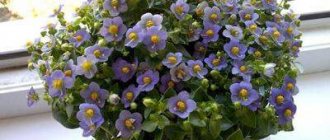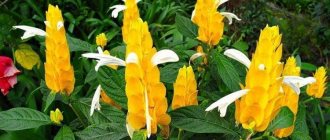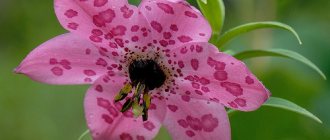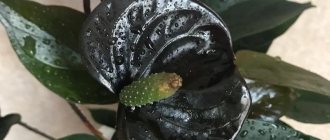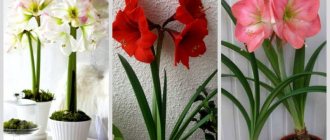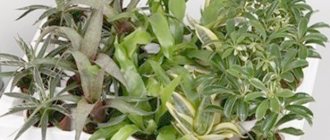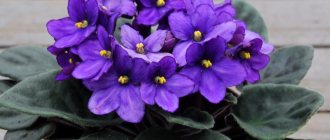Tolmiea flower
Family Saxifraga
Tolmia forms a compact (up to 22 cm tall) bush of pubescent bright green leaves. At the base of adult leaves, suckers are formed. This is one of the hardiest indoor plants and thrives in a cool, well-ventilated area away from direct sunlight. Hot and dry air is destructive for her.
Types of indoor plants
T. menziesii (T. Menzies) is the most common plant that produces shoots on the leaves. She is extremely unpretentious. Due to the long petioles of the leaves it looks like a hanging plant.
- Temperature:
Moderate or slightly below moderate, in winter not lower than 6°C. - Lighting:
Prefers bright light, can also grow in the shade. - Watering:
Abundant, the soil should remain moist at all times; In winter, watering is reduced. - Air humidity:
Leaves should be sprayed from time to time. - Replanting:
Every year in spring. - Reproduction:
The offspring are covered with earth; After rooting, the stems are cut off.
Torenia
Tradescantia flower
Family Commelinaceae
The main representatives of this group are tradescantia, zebrina and callisia. These plants seem to be most commonly placed in hanging baskets. They have leaves with tubular sheaths that enclose creeping or drooping stems. To enhance branching, the ends of the stems are regularly pinched, shoots with single-color leaves are removed as they appear. Can tolerate cool conditions in winter. Setcreasia is also unpretentious and can grow as a hanging plant, but it has longer leaves. Cyanothis has densely pubescent succulent leaves. All members of this family Commelinaceae can sometimes bloom indoors, but the flowers, as a rule, do not have decorative value. Like many other families, this one has its own “tough nut to crack” - a difficult plant to cultivate. To grow green manure, which has wide, colorful leaves gathered in a rosette, requires considerable skill and high air humidity.
Secrets of success in flower care
- Temperature:
Moderate, in winter not lower than 8-12°C (14°C for green manure). - Lighting:
Photophilous. Zebrina, netcreasia and cyanotis respond well to some direct sunlight. Siderasis requires partial shade. - Watering:
Abundant from spring to autumn, moderate in winter. - Air humidity:
Leaves should be sprayed from time to time; siderasis requires frequent spraying. - Replanting:
If necessary in spring. - Propagation:
Very simple, by stem cuttings in spring, summer or autumn. Siderasis is propagated by division.
Particular difficulties when caring for a plant
There are few leaves on elongated stems Cause: Lack of light, moisture and nutrition. Over time, the stems tend to become bare and twisted. Unsightly stems are cut off; old plants are replaced.
Single-color leaves Cause: Lack of light. In the shade, the variegated leaves turn green.
Withered stems, yellow spotted leaves Cause: Lack of moisture. During the growth period, plants are watered abundantly as the soil surface dries.
Brown, dry leaf tips Cause: Too dry air
Pay attention to whether the plant is affected by spider mites. Remove dead leaves promptly
Spray the leaves more often.
Thunbergia
Shrub with red sour berries.
List of plants starting with the letter “x”
It is interesting that the words cranberry and spreading cranberry as a common noun for all kinds of absurdity and nonsense are attributed to B.F.
Vasilisa kept order in the Cranberry swamp entrusted to her, but while the cranberries were blooming, there was absolutely nothing to do in the swamp.
On the road, everything is measured in kilometers: twenty-two - a swamp, cranberries; thirty-ninth - old bridge, dismantled road; forty-seventh - the road to the city, the opportunity to sell at least something to passers-by: cranberries, potatoes, squirrel mittens.
And then the fish will appear, it’s generally easier in the summer, the cranberries will grow, but they will suffer from scurvy - they are afraid of cranberries like fire.
You see, he’s snacking on cranberries, which means he’s been drinking for a long time... I know he doesn’t eat anything, just vodka and cranberries.
Artificially grown cranberries are much larger than ordinary cranberries growing in the swamp; individual berries reach the size of cherries.
It was later that they nicknamed Zhuravlin, when during a drawing lesson Isidor Semyonovich showed a drawing where a cranberry was depicted and asked what the name of such a berry was.
For weight, it is added, although besides it there is a lot more: the cabbage itself, covered with skulls; loose apples in a convenient piece, which is why they are easily swallowed, as if he himself had regurgitated them first; also cranberries and even grapes.
T
List of plants starting with the letter n: indoor, garden and vegetable plants
Meadowsweet or spirea (lat. Spiraea)
Meadowsweet (lat. Spiraea) belongs to the rose family (lat. Rosaceae) and is a perennial flowering shrub. The stem branches well and responds well to formative pruning.
(lat. Spirea japonica)
This type of meadowsweet is decorative in everything. Its stem is pubescent, with a ribbed or striped texture of a reddish color.
Tamarix (lat. Tamarix) Tamarix (lat. Tamarix) belongs to the Tamarix family (lat. Tamaricaceae) and is a perennial tree-like shrub. The shape of the bush structure, leaves, and inflorescences are also decorative.
(lat. Thelocactus)
The genus Telocactus (lat. Thelocactus) unites about 10 species. It belongs to the large Cactus family (lat. Cactaceae). The homeland of Telocactus is Mexico. The most common four species of Telocactus are found in culture. But most often, gardeners grow Telocactus setispinus (lat. Thelocactus (Hamatocactus) setispinus).
Telocactus setispinus (Telocactus setispinus) (lat. Thelocactus setispinus, Hamatocactus setispinus)
Tetrastigma (lat. Tetrastigma voineriana)
Tetrastigma Voineriana, Voinier Grape (lat. Tetrastigma voineriana) belongs to the Grape family (lat. Vitaceae) and is a large perennial vine with powerful stems and young shoots.
Tetrastigma Voinierianum (lat. Tetrastigma voinierianum)
Tephrocactus jointed (lat. Tephrocactus)
Tillandsia (lat. Tillandsia)
Many representatives of the Tillandsia species use their roots not to absorb useful substances from the soil, but only as a way of attaching to trees and stones, and they receive everything they need for their development through the leaves. It is these flowers that are called atmospheric or gray tillandsias.
Tillandsia Linden (lat. Tillandsia lindenii)
Tillandsia blue (lat. Tillandsia cyanea)
Tillandsia usneoide (lat. Tillandsia usneoide)
Tillandsia usneoide belongs to the Bromeliaceae family (Latin Bromeliaceae) and is a herbaceous perennial plant. This type is considered the most common.
Tradescantia (Setkresia, Zebrina, Woman's Gossip) (lat. Tradescantia)
Caring for a Tradescantia flower requires good lighting. She can feel great both in partial shade and in the sun. But the plant has some peculiarities.
see also:
Homeland of Tradescantia
White-flowered Tradescantia (Tradescantia tricolor, Tradescantia uridis) (lat. Tradescantia albiflora)
Tradescantia Blossfeldiana (lat. Tradescantia blossfeldiana)
Tradescantia variegated (Rheo) (lat. Rhoeo discolor, Tradescantia spathacea)
Trachycarpus (lat. Trachycarpus)
Trachycarpus do not like direct sunlight, so the optimal lighting for them will be diffused light or shade. Since palm leaves grow faster on the side exposed to the sun, the plant needs to be rotated once every two weeks.
Trachycarpus fortunei (lat. Trachycarpus fortunei)
Brazilian Trithrinax (lat. Trithrinax brasiiensis)
Thunbergia (lat. Thunbergia)
This wonderful liana came to us from the tropical countries of Asia and Africa, where 200 species of thunbergia are found. There are several varieties of the plant: fragrant, large-flowered, erect, Vogel's thunbergia and winged thunbergia.
Winged Thunbergia (lat. Thunbergia alata)
Thunbergia erecta (lat. Thunbergia erecta)
Turbinicarpus (lat. Turbinicarpus)
Turbinicarpus (lat. Turbinicarpus) belongs to the Cactus family (lat. Cactaceae) and is a perennial succulent. Its stem reaches a diameter of 5 cm and is decorated with large tubercles and spines that are strongly curved.
Turbinicarpus schmiedickeanus (lat. Turbinicarpus schmiedickeanus)
Large-spined turbinocarpus (lat. Turbinicarpus macrochele)
Thuja (lat. Thuja)
Thuja tolerates a shaded place well, but if there is too little light, it may begin to lose the splendor of its forms. The rays of the sun directly falling on the leaves of the thuja can cause burns, so the best environment for the thuja is a place with abundant but diffused light. You can place the thuja on a small table in front of the window.
Tulip (lat. Tulipa)
Tulips are able to grow in a wide temperature range from 2°C to 30°C; at the beginning of growth they tolerate temperatures of -18°C.
A B C D E F G H I K L M N O P R S T U V
Poisonous garden plants
People are setting up summer cottages for relaxation; at this time, you don’t want to think about any dangers that could harm your health. But with information, you can avoid many troubles. Many garden crops can be dangerous, here are some of them:
- Narcissus is a beautiful flower that many gardeners grow for pleasure. But not everyone knows that the plant’s bulbs are poisonous. They contain lycorin. Once in the body, it causes a gag reflex.
- Hyacinth is a frequent visitor to a summer cottage. Its bulbs are poisonous and are confused with onions. If you season a salad with it, due to negligence, digestion will be disrupted.
- Kupena is a herbaceous plant, used in the garden for decorative purposes.
- White ash tree is a beautiful flower, popularly called the “burning bush.” It has the ability to increase the sensitivity of the skin to ultraviolet radiation. If it grows in the country, then you should wear gloves when working with it.
Related article: Family of Acanthus plants: list, description, genera and species
Garden plants should be used with caution, as their juice, if it gets into the eyes and skin, causes irritation.
Tetrastigma flower
Family Grape
Coniferous plants for the garden and dacha: catalog of plants with descriptions
The main decoration of the tetrastigma is leaves covered with dense brown hairs. They consist of 3-5 lobes and reach 25 cm in diameter. The edges of the leaf blades are serrated. Young shoots and tendrils are also densely pubescent. Overall, Tetrastigma is a very attractive plant. If you decide to develop tetrastigma, consider how you will limit its growth. A rejuvenating haircut, removal of part of the roots during replanting, and keeping them in close quarters will help you. We do not recommend restricting tetrastigma in nutrition: this causes the leaves to become smaller and less attractive, and the number of leaf lobes decreases. If you can provide a high temperature (20-25°C), then propagation of tetrastigma by cuttings can be carried out all year round. A fragment of a stem with a single leaf and an axillary bud will be sufficient. When planting in a mixture for cuttings, the bud must be above the substrate, otherwise a new shoot will not form. Rooting lasts about a month. After this, transplant the young plant into a mixture of sand, compost and turf soil in equal proportions. Provide support for the growth of tetrastigma, or use it as an hanging plant. Tetrastigma prefers bright, diffused light and regular watering. Tolerates dry air relatively easily. Tetrastigma is damaged by aphids, spider mites, and nematodes. Tillandsia
Tulipa flower
Liliaceae family
To obtain lush, well-developed flowers as a result of forcing, only large bulbs 5-6 cm in diameter are planted. The bulbs selected for forcing must have flower buds. To check, test bulbs are cut to length. Before planting in pots, purchased bulbs can be kept at the bottom of the refrigerator or in a cool place in the room. It is known that for the normal flowering of bulbous plants during forcing, especially tulips, the temperature conditions of storing the bulbs after digging have a great influence. It is unknown under what conditions the purchased bulbs were stored. Therefore, it is advisable to purchase them immediately after digging and drying. They must first be stored at a temperature of 17 °C, and from August until planting in pots - at 9 °C. In late autumn (from October 10 to October 20), they are planted in 13 cm pots. Three bulbs of the same variety are usually planted in a pot so that they do not touch and the tops are not covered with soil. When planting bulbs, you need to make sure that the flat side is facing the wall of the pot. In this case, the first leaf to grow will face outward and give the plant a more decorative appearance. The earth mixture is prepared from turf and humus soil (two parts each) and sand (one part). After planting the bulbs, the soil in the pots is moistened. Pots with planted bulbs can be kept on the balcony in boxes, covered with wet peat or sawdust on top. You can also bury them in the front garden in the ground to a depth of 30-40 cm. A layer of peat or sawdust is poured under the pots and on top so that it is easy to dig out in winter. For this purpose, some amateurs place a board on top of peat and sawdust, on which a layer of sawdust is poured on top. The best temperature for successful rooting of bulbs is 8-9 ° C heat. The time for digging up pots with bulbs and bringing them into the room for forcing is determined by the desired period of flowering of the tulips. It has been established that the greatest need for flowers falls on March 8th. In this regard, the timing of forcing tulips has already been checked. Pots with rooted bulbs are brought into the room 25 days in advance, that is, February 10-11. They are placed in the kitchen, covered with a black cloth and watered regularly. Under such conditions, the sprouts stretch out. When they reach 8-10 cm, the plants are transferred to the windows. Shaded from direct sunlight. Sewing supplies from the Hobby Express store will help you sew a beautiful fabric cape for a flower. For longer flowering of tulips, flowering plants must be kept at a lower temperature. The best varieties of tulips for early forcing: - with cream-pink flowers; - dark pink; - with red flowers; for middle and late forcing: - with orange-red, - with red flowers with a white border; , , , - red, - with black flowers.
Tillandsia flower
Family Bromeliads
Unfortunately, only tillandsias are offered in stores. The most common is Tillandsia usneiformes. In appearance, it bears little resemblance to a flowering plant. The greenish-gray densely intertwined twigs represent a complex branched system of shoots with tiny rosettes of leaves. This plant is much closer in appearance to lichens: in humid areas of the USA and Mexico, it hangs abundantly from all objects on which it managed to settle. There is no need to specially strengthen the tillandsia on a support; it is enough to hang it, providing the opportunity to grow downwards. The rest of the tillandsias are more like bulbs with tightly closed leaf bases that bend to the side only at the top. The bulbous part accumulates moisture flowing from the leaf blades. The size of the leaves and their shape determine the appearance of each species. Thus, in Tillandsia “Medusa’s head” the bases of the leaves are wide and their ends are curled. The grayish color and serpentine leaf blades reminded botanists of the myth of the Gorgon Medusa, after whom this plant was named. In nature, this tillandsia lives in symbiosis with ants, which supply it with minerals and in return receive good protection and water. During flowering, an inflorescence appears from the “bulb” bearing blue flowers against a bright red background of bracts. Tillandsia violetflower has narrower, curved, but not curled leaves and reaches a height of only 5 cm. As the name suggests, the flowers are lilac in color. The bracts are red. Tillandsia silver has narrow plates that suddenly widen towards the base. They are curved and extend from the “onion” in disarray.
Tolmia
Healing herbs in the garden
It is customary to grow onions, dill, and parsley on a personal plot. Of course, these herbs are useful. But there are garden plants that are eaten for the health of the body and to decorate the area. Here are some of them:
- Amaranth is a herbaceous plant that resembles the taste of spinach. It is used for making soups, sauces, salads, and the dried leaves are used for brewing tea. The grains are the most valuable food for birds, and the stems with leaves are for livestock. Amaranth is used to treat tumors, radiation sickness and other diseases. The plant improves the structure of the soil; many people grow it simply for beauty.
- Fennel resembles dill in appearance. The seeds and greens of this plant are valued. Used to enrich the taste of dishes, for salads and canning vegetables. In medicine, the seeds are used to treat the nervous system, heart and other diseases.
Torenia flower
Family Norichinaceae
This annual plant blooms in summer and can be placed on a windowsill. Grown from seeds, which the flower is sown in early spring. The stems quickly stretch out; to enhance branching, their ends are pinched and supported. The flowers are very distinctive: the corolla is lilac, with a dark purple lower lip and a bright yellow spot. The plant is unpretentious - keep it in a well-lit place, water it regularly and avoid drafts.
Types of indoor plants
T. fournieri (T. Fournier) is a compact bush, when tied to a support it reaches a height of 25-30 cm. Suitable for placement in a hanging basket. The cultivated forms include alba (pure white flowers) and grandiflora (larger and more numerous flowers).
Secrets of success in flower care
- Temperature:
Moderate, approximately 12-20°C. - Lighting:
Bright diffused light. - Watering:
Abundant. - Air humidity:
Leaves should be sprayed from time to time. - Care after flowering:
The plant is thrown away. - Reproduction:
By seeds in spring.
Tradescantia
Plants with a strong smell
Some indoor flowers are notable for their strong and pungent odor. It doesn't matter how nice it is, it's still not the best option for a small, enclosed room. At a minimum, it is fraught with chronic headaches.
Geranium
Geraniums don’t even have to bloom, because the essential oils are contained in the leaves. They purify and disinfect the air, but provide a strong aroma throughout the year.
Rose
Rose is a well-known bright scent that many people like. But densely flowering bushes in the bedroom not only create a romantic atmosphere, but also provoke sleep problems.
Oleander
Many people find the smell of oleander attractive, but this does not make it any less pungent. When flowering, the plant releases too many essential substances into the air, which provoke migraines and suffocation.
Amazon lily
A beautiful flower with an exquisite tropical aroma and quite aggressive. It can cause discomfort and mild nausea in the mornings and nights, even if everything seems normal during the day.
Myrtle
Among the most popular plants for air purification is myrtle, but its aroma is notable for its expressive sedative properties. Not the best choice for a workplace where you need to constantly maintain concentration.
Azalea
The smell of azalea is a strong irritant and allergen, and simple ventilation is not enough. By the way, this also applies to other flowers related to rhododendrons.
Kirkazon
This bizarre medicinal plant is often bred precisely for its benefits. But the flowers contain alkaloids, a toxic substance that is best not inhaled at all.
Food products (alphabetically):
Do you know that:
According to WHO research, talking on a mobile phone for half an hour every day increases the likelihood of developing a brain tumor by 40%.
In order to say even the shortest and simplest words, we use 72 muscles.
Each person has not only unique fingerprints, but also tongue prints.
During operation, our brain expends an amount of energy equal to a 10-watt light bulb. So the image of a light bulb above your head at the moment an interesting thought arises is not so far from the truth.
The human stomach copes well with foreign objects without medical intervention. It is known that gastric juice can even dissolve coins.
Many drugs were initially marketed as medicines. Heroin, for example, was originally brought to market as a cure for children's coughs. And cocaine was recommended by doctors as an anesthesia and as a means of increasing endurance.
If your liver stopped working, death would occur within 24 hours.
Human blood “runs” through the vessels under enormous pressure and, if their integrity is violated, it can shoot at a distance of up to 10 meters.
In 5% of patients, the antidepressant Clomipramine causes orgasm.
According to many scientists, vitamin complexes are practically useless for humans.
People who eat breakfast regularly are much less likely to be obese.
Our kidneys are capable of purifying three liters of blood in one minute.
74-year-old Australian resident James Harrison has donated blood about 1,000 times. He has a rare blood type whose antibodies help newborns with severe anemia survive. Thus, the Australian saved about two million children.
Millions of bacteria are born, live and die in our intestines. They can only be seen under high magnification, but if they were put together, they would fit in a regular coffee cup.
The first vibrator was invented in the 19th century. It was powered by a steam engine and was intended to treat female hysteria.
Thorny thorn
The roots, bark and fruits of thorns are used in alternative medicine.
Sloe fruits have astringent properties and are recommended for patients with stomach and intestinal disorders, ulcerative colitis and dysentery. In most cases, the flowers are used as a laxative, the roots as a diaphoretic, and the bark as an antipyretic. Preparations from sloe flowers regulate intestinal motility, have diuretic and diaphoretic properties: 1. Infusion: 2 tbsp. Pour 400 ml of hot water over spoons of thorn flowers, leave for 1 hour and strain. Drink 1/2 glass 4 times throughout the day before meals. 2. Infusion: 2 tbsp. Pour 1 cup of cold boiled water over spoons of thorn flowers, leave for 8 hours and strain. Take 1/3 cup 3 times throughout the day. 3. Tea: 50 g of flowers are boiled in 1 liter of hot water. Used for constipation, kidney failure, and urinary tract diseases.
Preparations from the fruit are recommended for gastritis, spastic colitis, intestinal atony, cystitis, edema, rheumatism, furunculosis and skin diseases.
Decoction: 2 tbsp. Pour 500 ml of hot water over spoons of dried fruit, boil for 10 minutes and strain. Drink 1/2 glass 4 times throughout the day before meals.
Tea made from sloe leaves has a laxative effect, improves metabolism, and acts as an expectorant and diuretic. It is also drunk for chronic cystitis, adenoma, prostatitis and skin rashes.
The bark and roots of thorns have diaphoretic and antipyretic properties. At very high temperatures, use a decoction of thorn roots: decoction: 10 g of crushed thorn roots, pour 0.5 liters of water, boil the mixture over low heat for 15 minutes. Sip throughout the day.
For spastic colitis, a collection is used: a decoction: 2 parts each of thorn, rhubarb and elecampane flowers, 3 parts buckthorn bark and 2 parts mint leaves. 1 tbsp. Pour 300 ml of water into a spoonful of the mixture, boil for 10 minutes, strain and cool. Drink 1/2 glass 3 times throughout the day.
Woody plant without a main trunk.
Indian - evergreen (or semi-evergreen) shrub with beautiful bright flowers (the corolla is pure white, pink, red or variegated). Lit.: Trees and shrubs of the USSR, vol.
Among the bushes there were orange dodder flowers, clinging to the stems of neighboring plants that were dying from these embraces, but the bush was thick and plentiful.
There is protection all around: on one side there is a humpbacked rocky cape, on the other there is a chain of shallows densely overgrown with bushes and reeds, on the rear there are bushes and an impenetrably dark thicket of high forest.
I remember that we drove for an eternity, that there were countless fields, some hollows, country roads, and crossroads, and that on the road this is what happened: in one hollow—and it was already evening and the places were very remote—there were thick trees an oak bush, dark green and curly, and along its opposite slope a “robber” was making his way among the bushes, with an ax tucked into his belt - perhaps the most mysterious and terrible of all the men I had seen not only up to that time, but also in general throughout my entire life.
Grass turns into thickets gradually, thickets become bushes, bushes become trees, tenacious mustaches grab onto branches, vines crawl along trunks, Ashi takes a few more steps - and the jungle closes in behind him, above his head.
It is all dotted with heaps of low-growing trees, or rather bushes, scorched by the sun in summer and bare in winter; The bushes are brown - everything here is brown, right up to the very mountains, where there are gray, silvery and yellowish shadows, like freshly cut forest.
In the center stood an old tree with a straight, ashen trunk, around which large and small bushes grew, and in the thickets of bushes there were various herbs and different colors.
At first she saw only the blue sky, then yellow-leaved bushes and, against the background of bushes, caps and hats with folding headphones, above which the ends of the vines flew up.
I remember that we drove for an eternity, that there were no number of fields, some hollows, country roads, intersections, and that on the road this is what happened: in one hollow—and it was already evening and the places were very remote—there were thick trees an oak bush, dark green and curly, and along its opposite slope a “robber” was making his way among the bushes, with an ax tucked into his belt - perhaps the most mysterious and terrible of all the men I had seen not only up to that time, but and in general throughout my life.
Echeveria DC. flower
Family Crassulaceae
Recently, the popularity of these Mexican plants has increased markedly. They are supplied in the form of sets in which you can choose any plant you like based on the color and shape of the leaves. And in nature there are more than 150 species.
Echeveria agave has pointed leaves with a brown point at the top, Echeveria Darenberga has broad-scapulate leaves, and Echeveria bristlecone leaves are covered with numerous white bristles. The rosettes of Echeveria humpiflora are green, with a dull reddish tint, which is enhanced to bronze in the metallica form, while in the crispata form of the same species the leaves are slightly wavy along the edges.
When young, all echeveria form a rosette of alternate leaves. But not every plant purchased retains it forever. Over time, the stems lengthen, lie down, and the rosettes end up far from the pot - at the very top of the shoot. Echeverias often bloom in rooms. As a rule, the rosette that produced the peduncle does not survive and dies. Below, shoots with small scale-like leaves and long internodes are formed (this is how Echeveria strives to settle its children away from the mother’s outlet). This is the second reason for the loss of decorative effect in echeverias. The third reason may be lack of light.
To restore the attractiveness of your echeveria collection, propagate them often, as the most beautiful are the young specimens. Everything will be used - the tops of overgrown shoots, “spreading” shoots, and basal rosettes. The best time for breeding is March - May. Echeverias are very popular as annual plants for alpine hills. But do not forget to leave at least one queen specimen of each species in the room over the winter, which will allow them to be renewed the next year.
Echeverias prefer to overwinter at 6-7°C, but they can also tolerate higher temperatures.
Of some interest is also a close relative of Echeveria - pachyphytum ovatiformes, which has almost spherical leaves attached to a straight stem. Care is similar to that recommended for echeverias.
Personally, I only know Edelweiss; I still remember this name from school. In my opinion, this is a high-altitude alpine flower from the genus of violets. This name is associated with something from the Second World War, like the Jaeger detachments or mountain riflemen in the Third Reich.
But then I rummaged around on the Internet and it turns out that there are colors starting with quot; equot; - a lot!!!
I know a few flowers starting with the letter quot;Equot;, here they are: Episcia (indoor flower), Echeveria (gray, agave-shaped and derenberga), Edelweiss, Eustoma, Eucharis, Eremurus, Erantis, Aeonium, Evening primrose, Echinopsis, Exacum, Edrayanthus. Among the listed flowers there are many indoor ones. Very beautiful names of the listed colors :-) .
I would say that the letter quot;Equot; the richest). In fact, many houseplant names begin with this letter. And there are a lot of non-indoor flowers with this letter!
Edelweiss
— there are more than thirty species of them, they grow in bushes and serve as decoration for any garden. The most interesting thing is that after drying, edelweiss flowers retain their original shape and color, so they can be preserved in this form during the winter.
And look at this extraordinary flower! This is echmea
, indoor flower. She is whimsical - she loves warmth, sun, humidity. If it is cold, it changes color. Has healing properties.
Echinacea
- this is generally a beautiful plant, which in my imagination is associated with the Indians). She has a rich range of healing qualities. Echinacea is successfully used in the treatment of depression, lupus erythematosus, stomach and intestinal diseases, skin diseases, to improve immunity, etc.
Escobaria
is a genus of cacti. It has white, densely planted needles and cream-colored flowers. The plant looks very attractive!
Color names
On this page you can see the names of flowers and their photos. At the moment, the site contains articles on the care and cultivation of 150 of the most popular flowers. By going to the flower by letter page, you can see photos and names of more than 400 houseplants.
Names of flowers with photos
- adding new names;
- adding new photos;
- adding new varieties;
- adding new videos.
AbutiloneAglaonemaAdeniumAzaleaAlocasiaAloeAmaryllisAnthuriumAraucariaArdisiaAsparagusAspidistraAucubaBabmukBalsamBegoniaEveronymusGardeniaCarnationDahliasGeraniumGerberasHyacinthHibiscusHippeastrumGladiolusGloxiniaHydrangeaGuzmaniaDendrobiumDiffen bahiaDracaenaJasmineZamioculcasCactiKalanchoeCalatheaCallisiaCalceolariaCamelliaSaxifrageCatharanthusClerodendrumCliviaColeusCrocusCrotonLedeburiaLilyLemonArrowrootMonsteraNarcissusNepenthesNolinaOleanderOpuntiaOrchidsPandanusFernPassifloraPachistachisPepper IaPetuniaPeonyPrimulaPoinsettiaRadermacherRoseBoxwoodSansevieriaSelaginellaSpathiphyllumStephanotisStreptocarpusScindapsusTillandsiaCrassulaTradescantiaTulipsPhalaenopsisVioletsFicusPhilodendronFittoniaFreesiaFuchsiaHamedorrheaChlorophytumHoyaChrysanthemumCymbidiumCyper usSchefflerSchlumbergerEucharisEchmeaYucca florino.net
Flowers starting with the letter T – Flower Library
- Alphabetical index Flowers starting with the letter A
- Flowers starting with the letter B
- Flowers starting with the letter B
- Flowers starting with the letter G
- Flowers starting with the letter D
- Flowers starting with the letter E
- Flowers starting with the letter J
- Flowers starting with the letter Z
- Flowers starting with the letter I
- Flowers starting with the letter K
- Flowers starting with the letter L
- Flowers starting with the letter M
- Flowers starting with the letter N
- Flowers starting with the letter O
- Flowers starting with the letter P
- Flowers starting with the letter R
- Flowers starting with the letter C
- Flowers starting with the letter T
- Flowers starting with the letter U
- Flowers starting with the letter F
- Flowers starting with the letter X
- Flowers for the letters C, Ch, Sh, Shch
- Flowers for the letters E, Yu, Z
Flowers by category
- cacti
Indoor flowers Red Book of Flowers Shrubs and flowering trees Medicinal flowers Forest flowers Wild and meadow flowers Garden flowers Poisonous flowers Diseases and pests Interesting articles
- Alphabetical index
- Flowers by category
- Diseases and pests
- Interesting articles
New articles
- Types of bulbs
- Nectaroscordum
- Mullein
Flowers library / Flowers starting with the letter T Tobacco Meadowsweet Tevetia Tecomaria Cape Thyme Tolmia Jerusalem artichoke (Earth Pear) Tradescantia Tung Yarrow Tulip← Flowers starting with the letter CFlowers starting with the letter U →
Flowers starting with the letter T. Photos and names of flowers and indoor plants starting with the letter T.
All flowers 362
Jasmine flowers are one of the genus of vine-shrubs of the olive family. Jasmine is a forever plant
Pests 265
Thrips (Fringedwings, Bladderwings) are a very common type of parasite. Thrips affect both decorative and indoor plants.
There are more than 35 thousand species and varieties of orchids in the world. This also includes
Video 474
Kalanchoe is a unique representative of the Crassulaceae family. It is known to be a medicinal plant, but few people
Photo galleries 556
The lovely lily is a very beautiful and unusual plant, but you must remember that it is poisonous and
All flowers 288
Clivia is a plant of the Amaryllis family. Clivia is native to the tropical rainforests of South Africa.
florino.net
Garden crops
The names of garden plants and the fruits of these plants are very diverse. There are a huge number of species, varieties and varieties. Here are some of them:
- Root vegetables: radishes, turnips, rutabaga, carrots, potatoes.
- Leafy plants: lettuce, spinach, sorrel.
- Spicy flavors: basil, dill, celery, parsley.
- Melons: watermelon, melon, pumpkin, zucchini, squash.
- Legumes: peas, beans.
- Cabbage crops: white and red cabbage, kohlrabi, Brussels sprouts, Peking cabbage, cauliflower.
- Herbaceous plants: leeks and shallots, asparagus and garlic, beets and cucumbers, tomatoes and peppers.
Garden plants, depending on the species, are grown in different ways. But one thing remains unchanged - the creation of optimal conditions for growth.
Related article: Poppy plant family: list, description, genera and species
Social place names starting with the letter L
Names of states starting with the letter L
- Laos is a state in Southeast Asia
- Latvia (Europe).
- Lesotho (Africa).
- Liberia (Africa).
- Lebanon is a state in the Middle East.
- Libya is a state in northern Africa.
- Lithuania, Republic of Lithuania (Europe).
- Liechtenstein is a dwarf state in Europe.
- Luxembourg is a city-state in Europe.
Names of cities starting with the letter L
- La Paz is the government center of Bolivia (South America).
- Leipzig (Europe).
- Leningrad is the Soviet name for St. Petersburg, the center of the Leningrad region.
- Libreville is the capital of Gabon (Africa).
- Lilongwe is the capital of Malawi (Africa).
- Lima is the capital of Peru (South America).
- Lipetsk is the center of the Lipetsk region in the Central Federal District of the Russian Federation.
- Lisbon is the capital of Portugal (Europe).
- Lome is the capital of Togo (Africa).
- London is the capital of Great Britain (Europe).
- Luanda is the capital of Angola (Africa).
- Lugansk is the center of the Lugansk region of Ukraine
- Lusaka is the capital of Zambia (Africa).
- Lviv is the center of the Lviv region of Ukraine
- Lubeck (Europe).
- Ljubljana is the capital of Slovenia (Europe).
- Luxembourg is a city-state (Europe).
